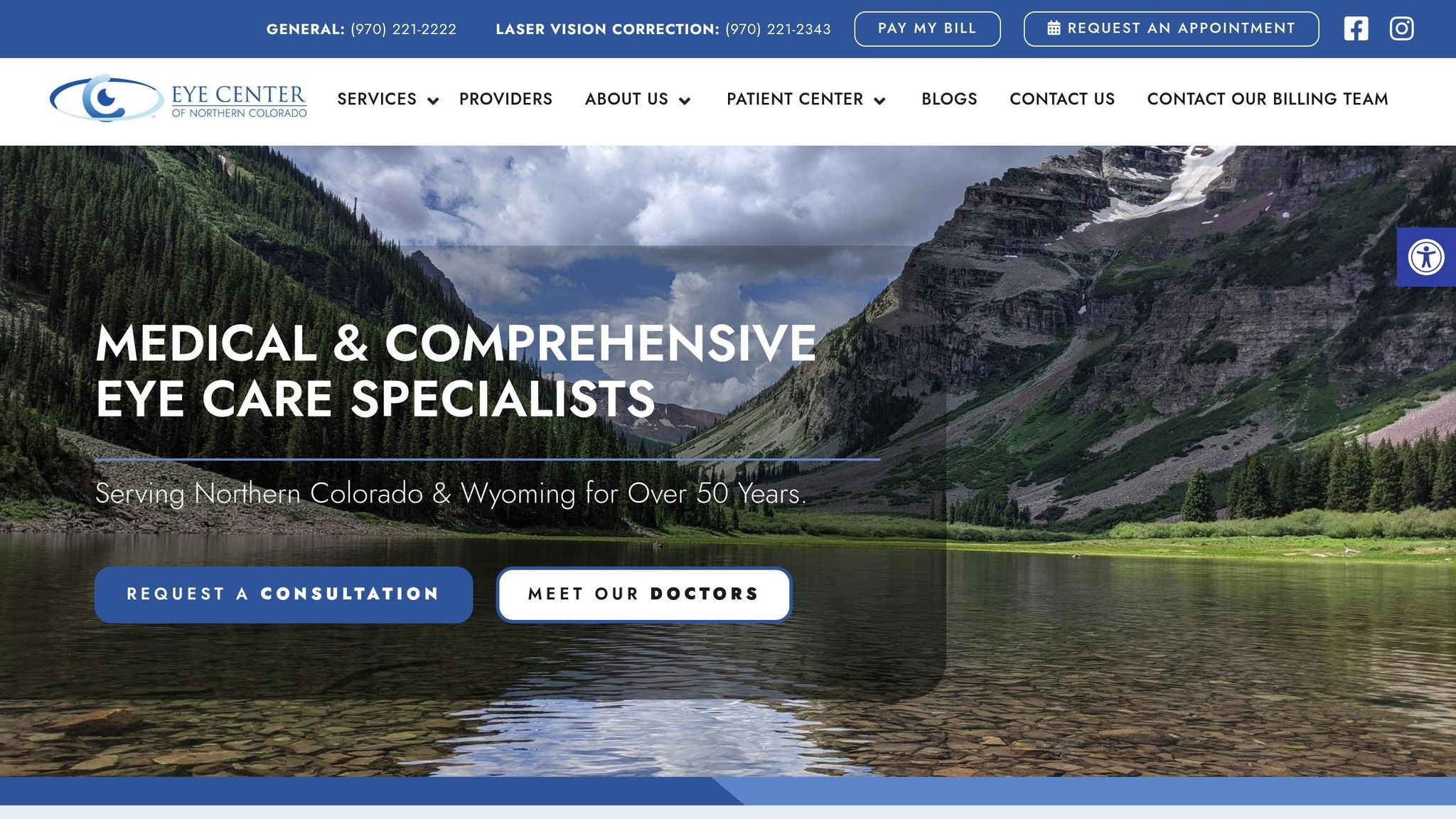Switching from glasses to contact lenses can improve your vision experience, offering a wider field of view and eliminating issues like fogging or raindrops on lenses. However, the transition requires learning proper hygiene and handling techniques to ensure comfort and safety. Here’s what you need to know:
- Adjustment Period: Mild discomfort, dryness, or irritation is common in the first few weeks. Start with short wear times (2–4 hours) and gradually increase.
- Handling Contacts: Practice inserting and removing lenses carefully. Clean hands are essential to avoid infections.
- Care Routine: Use fresh cleaning solution daily, avoid water exposure, and replace lenses as recommended (daily, bi-weekly, or monthly).
- Professional Fitting: A contact lens fitting ensures the right type and prescription for your eyes, which may differ from glasses.
- Backup Glasses: Always keep glasses handy in case of irritation or lens issues.
With proper care and guidance from an eye care provider, contact lenses can provide clear, hassle-free vision for most activities. Regular check-ups help maintain eye health and address any concerns.
Contact Lens Tips for Beginners | Eye Doctor Explains
What to Expect During the First Few Weeks
The first few weeks of wearing contact lenses are all about getting used to them. Your eyes need time to adjust to having lenses on their surface, and during this period, it’s normal to experience some sensations that almost every new wearer encounters.
Initial Discomfort and How to Handle It
It’s common to feel some mild discomfort, dryness, or irritation at first. This happens because contact lenses rest directly on your cornea, separated only by a thin layer of tear film, unlike glasses, which sit about 12 millimeters away from your eyes. Your tear film needs time to adapt to this new setup.
These sensations usually fade within a few weeks as your eyes get used to the lenses. A good starting point is to wear your contacts for 2–4 hours on the first day, gradually adding 1–2 hours each day. By the end of the first week, most people can comfortably wear their lenses for 8 hours or more.
Proper insertion and removal play a big role in reducing discomfort. During your fitting appointment, your eye care professional will teach you the correct techniques, and with regular practice, you’ll quickly get the hang of it. This will also help you tell the difference between normal adjustment discomfort and issues caused by handling errors.
To ease dry eyes or irritation during this period, blink often to help spread tears evenly across your eyes. Rewetting drops designed specifically for contact lens wearers can also provide relief – just make sure to use ones recommended by your eye care provider. If discomfort persists beyond the adjustment phase or worsens, don’t hesitate to reach out to your eye care professional for advice.
Once your eyes adjust, you’ll start to notice the many benefits of wearing contact lenses.
Advantages of Contact Lenses
After the initial adjustment, the perks of contact lenses become clear. One major advantage is improved vision. Since contacts move with your eyes, they provide a full field of focused vision, unlike glasses, which can limit your peripheral view due to their frames.
Many people also enjoy the aesthetic freedom that comes with contact lenses. Without frames, you can maintain your natural look, choose any style of sunglasses, and feel more confident in both social and professional settings.
Soft contact lenses, which contain more water, are often more comfortable for new wearers.
According to the CDC, around 45 million Americans wear contact lenses, and most new users adapt within 1–2 weeks. In fact, many find that the initial discomfort fades within just a few days. Knowing that this adjustment period is temporary can help you stay committed and fully enjoy the advantages of contact lenses.
How to Make the Switch Successfully
Switching to contact lenses is a process that benefits from careful planning and guidance from an eye care professional. By following these steps, you can ease into the transition and enjoy the perks of clear vision and the freedom contacts provide.
Getting a Professional Contact Lens Fitting
A contact lens fitting goes beyond a standard eye exam – it’s the cornerstone of a smooth transition to wearing contacts. During this appointment, your eye care provider evaluates not only your vision prescription but also the unique features of your eyes to ensure the lenses fit properly and feel comfortable.
This process involves measuring critical aspects of your eyes, like their shape and size, to determine the right lens type, material, and curvature. It’s important to note that contact lens prescriptions differ from glasses prescriptions. Glasses sit about 12 millimeters away from your eyes, while contact lenses rest directly on your cornea, separated only by a thin tear film.
For those with strong prescriptions – typically over ±4.00 diopters – contact lenses often require less corrective power than glasses. For weaker prescriptions, the difference may be minimal, but precise measurements are still vital for comfort and safety.
Your eye care professional will also evaluate if contacts are suitable for you, considering factors like dry eyes, allergies, or your daily activities. During the fitting, you’ll try out various lens options and learn how to properly insert, remove, and care for them before heading home with your new lenses.
Once your fitting is complete, the next step is mastering the techniques for safe and effective lens handling.
How to Insert and Remove Contact Lenses
Properly inserting and removing contact lenses is essential for comfort and maintaining eye health. While your eye care provider will guide you through the process during your fitting, becoming confident with these techniques takes practice.
Inserting lenses starts with clean hands – wash them thoroughly with soap and water, then dry them with a lint-free towel. Before placing the lens on your eye, check that it’s not inside out by making sure it forms a cup shape rather than flaring at the edges. Facing a mirror, hold your upper eyelid with one hand while pulling down your lower lid with the other, and gently place the lens on your eye using your index finger.
Common mistakes include skipping proper handwashing, which can introduce bacteria and lead to infections, or inserting the lens upside down, causing discomfort and blurry vision. Many first-time users also feel anxious about touching their eyes, leading to blinking or hesitation during insertion.
Removing lenses involves looking upward and sliding the lens down onto the white part of your eye. Use the pads of your thumb and index finger to gently pinch it off. Avoid using your fingernails, as they can damage the lens or scratch your eye. The key is to stay calm and use light pressure – rushing can make the process harder.
With time and repetition, these steps will become second nature. Your eye care provider will likely give you written instructions to take home, and if you’re struggling, don’t hesitate to schedule a follow-up for additional guidance.
Once you’re comfortable handling your lenses, you can gradually increase your wear time to help your eyes adapt.
Starting with Short Wear Times
Your eyes need time to get used to wearing contact lenses. Since lenses reduce the amount of oxygen reaching your cornea compared to open-air exposure, starting with shorter wear times helps your eyes adjust.
Your eye care provider will give you a personalized wear schedule based on your eye health and the type of lenses you’re using. Some people adapt fully within a few days, while others may need up to a month.
This gradual approach also allows you to refine your insertion and removal techniques in a less stressful setting and spot any early signs of discomfort or improper fit. If you notice persistent redness, discomfort, or changes in your vision, remove your lenses immediately and consult your eye care provider.
Keeping Your Eyes Comfortable and Healthy
Taking care of your eyes while wearing contact lenses involves sticking to daily habits and maintaining good hygiene. According to the CDC, nearly all contact lens-related issues stem from poor hygiene and maintenance, making these practices critical for safe and comfortable lens wear.
Avoiding Dry Eyes and Irritation
Dry eyes and irritation are common hurdles for contact lens users, often caused by reduced tear film stability, environmental factors, or overextending lens wear time.
Environmental factors like air conditioning, heating, and excessive screen time can exacerbate dryness. To ease these effects, avoid direct drafts, consider using a humidifier, and make small adjustments to your surroundings to enhance comfort.
Preservative-free artificial tears designed for contact lens wearers can be a game-changer, especially in dry environments or during long hours in front of a screen.
Switching to daily disposable lenses could also make a difference. Since these lenses are discarded after a single use, they eliminate the risk of protein deposits, allergens, or bacteria building up. Silicone hydrogel lenses are another great option – they allow more oxygen to reach your cornea, which can improve comfort and reduce dryness.
If dryness persists beyond the adjustment phase, consult your eye care provider. Persistent symptoms might indicate an underlying dry eye condition or the need for a different lens material.
Daily Cleaning and Care Routine
A consistent cleaning routine is non-negotiable for healthy contact lens use. Skipping steps or cutting corners can lead to discomfort or even serious infections.
- Always use fresh solution: Discard old solution and refill your lens case with fresh multipurpose solution every time you store your lenses. This ensures proper disinfection and prevents bacterial growth.
- Avoid water exposure: Never rinse lenses with tap water, as it can introduce harmful microorganisms like Acanthamoeba, which can cause severe infections. This rule applies to all water sources – whether it’s tap water, swimming pools, or hot tubs.
- Replace your lens case regularly: Even if it looks clean, replace your case every 1–3 months. Bacteria can form invisible biofilms inside the case, contaminating your lenses. Use reminders to keep track of replacement dates.
Never use saliva or any non-sterile liquids to clean your lenses. If you find yourself without the proper solution, it’s safer to discard the lenses and wear backup glasses than risk an infection.
Hand Washing and Lens Replacement
Hand hygiene and timely lens replacement are just as important as cleaning. Wash your hands with soap and water for at least 20 seconds and dry them with a lint-free towel before handling your lenses. This simple step minimizes the risk of transferring bacteria or viruses to your eyes.
Avoid using hand sanitizers or applying lotions right before touching your lenses. These products can leave residues that irritate your eyes or damage the lenses. If you’ve used them, wash your hands thoroughly with soap and water afterward.
Stick to the recommended replacement schedules for your lenses. For example:
- Daily disposables should be discarded after one use.
- Bi-weekly lenses should be replaced every 2 weeks.
- Monthly lenses should be replaced every 30 days.
Failing to follow these schedules increases the risk of infections, discomfort, and vision issues due to protein and lipid buildup. To stay on track, set reminders on your phone or align your replacement schedule with specific dates, like starting new lenses on the first of each month.
Always have backup glasses handy. They’re essential if you need to remove your lenses due to irritation or other problems.
Contact lenses, when properly fitted, allow tears to flow beneath them, delivering oxygen and nutrients to your eyes. By following these hygiene and replacement practices, you can maintain this natural process and keep your eyes healthy and comfortable throughout your contact lens journey.
sbb-itb-5ef6ec9
Solving Common Problems
Switching to contact lenses can feel a bit tricky at first, and it’s normal to face a few challenges during those initial weeks. But don’t worry – knowing how to handle common issues can make the process a whole lot easier.
Trouble Putting In or Taking Out Lenses
Even with instructions, many new users struggle with inserting and removing lenses at the start. Reflex blinking is often the biggest hurdle when putting lenses in. To overcome this, try practicing in a well-lit area with clean hands. Take it slow – there’s no rush.
If you drop a lens, pause and reset. Placing a clean towel on the counter can save you from losing lenses down the drain. For removal, the challenge is usually finding the lens if it shifts. Move your eyes in all directions – up, down, left, and right – to locate it. Sometimes, lenses can slip under the upper eyelid, which might feel strange but isn’t harmful.
Most people get the hang of lens handling within 1–2 weeks. At first, it might take 5–10 minutes to insert each lens. By the end of the first week, this often drops to just 2–3 minutes. After 4–6 weeks, the process usually becomes second nature.
It’s a good idea to keep your glasses nearby during this learning period. With practice, these early challenges will fade, allowing you to focus on other aspects, like maintaining comfort and building daily routines.
When Discomfort Doesn’t Go Away
Some discomfort is expected during the adjustment period, but it should improve noticeably within the first few days and mostly resolve by weeks 2–3. If it doesn’t, it’s time to dig deeper.
If you experience sharp pain, significant redness that doesn’t go away after removing the lens, excessive tearing, blurred vision, or light sensitivity, seek professional help immediately. These could signal a more serious issue.
Persistent discomfort often points to a poor lens fit. Signs include lenses that move too much when you shift your gaze, lenses that don’t stay centered, or a sensation that they’re too tight or loose. These issues won’t fix themselves and require adjustments from an eye care professional.
Blurred or unstable vision could mean a prescription issue, especially if it doesn’t match the clarity you experienced during your fitting. This is common for those with astigmatism, where vision might appear ghosted or blurry at certain angles.
If the discomfort continues beyond 2–3 weeks, reach out to your eye care provider. Many fit problems can be resolved by tweaking the lens size, shape, or material – often without needing a new prescription. Once discomfort is addressed, you can focus on building habits that support long-term comfort and eye health.
Building New Daily Habits
Making contact lens care part of your daily routine is key to success. The easiest way? Tie lens care to habits you already have.
For example, put your lenses in right after brushing your teeth in the morning and take them out before your evening shower or bedtime routine. This creates natural associations, making it easier to remember.
Set up a dedicated “lens station” in your bathroom with everything you need – solution, lens case, tissues, and backup glasses. If you use daily disposables, this is even simpler since you only need a spot for your glasses and a disposal bin.
Phone reminders can help during the first few weeks. You can even ask family members to nudge you until the routine feels automatic. It usually takes 3–4 weeks of consistent practice to form solid habits. Once those habits are in place, lens care becomes second nature.
Keep in mind that serious eye infections from contact lenses affect about 1 in 500 users each year, with most cases linked to poor hygiene and improper care. Starting strong with good habits protects your eyes and makes wearing lenses a comfortable, long-term solution.
Getting Professional Help and Support
Having professional support can make the transition to contact lenses much easier and help safeguard your eye health. This guidance builds on the foundation of your initial training and daily care habits.
Scheduling Regular Check-Ups
Most people who wear contact lenses should plan for a comprehensive eye exam at least once a year. If you’re new to wearing contacts or have specific eye conditions, your eye care provider might suggest more frequent visits.
These check-ups are crucial for catching potential problems early. During a follow-up appointment, your provider will check how well your lenses fit, evaluate the health of your cornea, assess tear film stability, and look for any signs of irritation or infection. They’ll also review your cleaning routine and help with any challenges you might face with inserting or removing your lenses.
If you experience ongoing discomfort, redness, blurry vision, pain, excessive tearing, or discharge, don’t wait – reach out to your provider immediately.
Contact Lens Support at Eye Center of Northern Colorado

The Eye Center of Northern Colorado offers comprehensive support to guide you through your contact lens journey. Their team of fellowship-trained professionals is dedicated to ensuring you have a safe and comfortable experience.
Your journey begins with a detailed eye exam and precise corneal measurements, followed by personalized recommendations for the best lens type for your needs. Follow-up appointments help reinforce your training and track your progress.
For those with specific needs, the center provides specialty fittings, such as toric lenses for astigmatism or multifocal lenses for presbyopia, ensuring your lenses are tailored to your vision requirements.
Patients value the center’s prompt and personalized care, especially during urgent situations or when vision changes occur. With multiple locations across Northern Colorado and Wyoming, the center ensures convenient access to expert support when needed.
From routine follow-ups to a wide selection of lens brands and expert advice, the Eye Center of Northern Colorado helps reduce the risk of complications while enhancing comfort. Their ongoing support empowers you to maintain healthy habits and address any issues quickly, so you can fully enjoy the benefits of contact lenses.
Conclusion: Making the Most of Your New Contact Lenses
Switching to contact lenses can bring a fresh perspective – literally and figuratively – to your daily life. While the adjustment period may take a few weeks, the advantages are well worth the effort.
Once you’re past the initial phase, you’ll notice the freedom they offer: no frames to block your peripheral vision, no fogging or water spots during bad weather, and the ability to fully engage in sports and other active pursuits. Since contact lenses move with your eyes, they provide clear, focused vision in every direction, creating a seamless and immersive experience.
The key to success lies in forming consistent habits. Simple routines like washing your hands before handling lenses, cleaning them properly, and replacing them as directed will quickly become second nature.
It’s also important to remember that contact lens prescriptions might differ slightly from those for glasses, especially if you have a stronger prescription. This is completely normal and part of the process.
Don’t underestimate the value of professional guidance during your journey. Regular check-ups with your eye care provider can help you stay on track, catch any potential issues early, and ensure you’re caring for your lenses correctly. For expert advice and personalized care, consider scheduling an appointment with Eye Center of Northern Colorado.
Lastly, always keep a backup pair of glasses handy. Your eyes may occasionally need a rest from contact lenses, especially during moments of irritation or illness. Having glasses ready ensures you’ll never be without clear vision when you need it most.
FAQs
What should I do if my contact lenses feel uncomfortable or cause irritation?
If your contact lenses are causing discomfort or irritation that doesn’t subside, it’s essential to stop using them and reach out to an eye care professional promptly. Ongoing discomfort might signal issues such as dryness, a poor lens fit, or even an eye infection.
The Eye Center of Northern Colorado specializes in addressing contact lens concerns. Their experienced team can evaluate your eyes, check the fit of your lenses, and offer advice on proper lens care to ensure you can wear them comfortably and safely.
How can I tell if my contact lenses fit correctly, and what are the signs they don’t?
Properly fitting contact lenses should feel natural, offering both comfort and clear vision. When lenses fit well, you shouldn’t experience irritation, redness, or excessive dryness. On the other hand, signs of a poor fit might include discomfort, blurry vision, a feeling that the lens is shifting around too much, or ongoing redness.
If you’re dealing with any of these problems, it’s best to stop wearing your contacts and reach out to your eye care provider. The team at the Eye Center of Northern Colorado is here to help. Our specialists can ensure your lenses fit just right and provide support as you adjust to wearing contacts.
How can I avoid dry eyes and irritation when wearing contact lenses in different environments?
To avoid dry eyes and irritation while wearing contact lenses, keeping your eyes hydrated and sticking to proper care routines is essential. Reach for preservative-free artificial tears to maintain moisture, especially if you’re in air-conditioned spaces or dry environments. And remember, rubbing your eyes can irritate both your eyes and the lenses – so try to resist the urge.
Always ensure your lenses are clean and replace them according to your eye care provider’s instructions. If you’re heading into windy or dusty conditions, a pair of sunglasses or protective eyewear can act as a shield for your eyes. Staying well-hydrated and taking regular breaks from screens can also go a long way in easing discomfort. If irritation continues, it’s worth consulting your eye doctor to check your prescription or explore alternative solutions.





